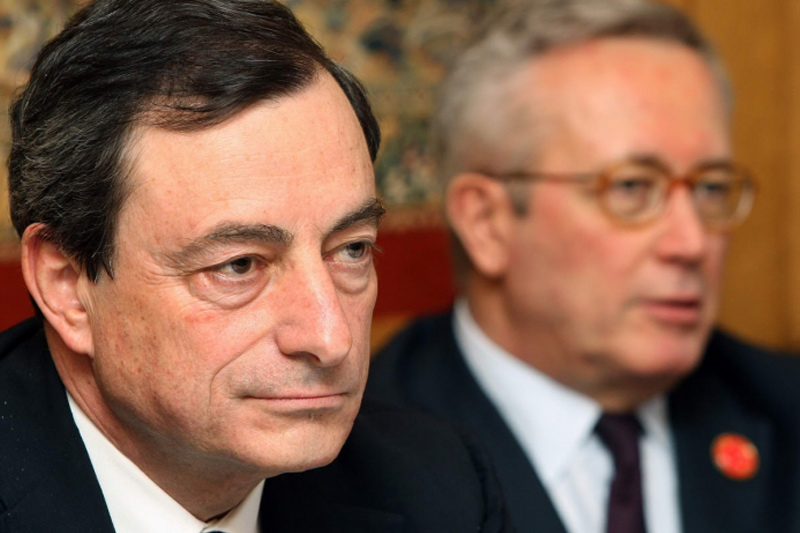Investing.com - The euro tumbled to a five-week low against the U.S. dollar on Thursday, adding to heavy losses as European Central Bank President Mario Draghi delivered opening remarks on the central bank’s earlier policy meeting.
EUR/USD hit 1.2377 during European afternoon, the daily low and the lowest since June 1; the pair subsequently consolidated at 1.2399, tumbling 1.05%.
The pair was likely to find support at 1.2335, the low from May 31 and resistance at 1.2607, Wednesday’s high.
The euro came under pressure after ECB President Draghi said that the economic outlook faces downside risks, adding that indicators for the second quarter point to weakening growth in the euro zone.
Draghi said that there was probably a "renewed weakness in economic growth" in the last three months, with "heightened uncertainty".
Draghi also refused to speculate on the chances of a third round of Long Term Refinancing Operations, in which it would provides cheap loans to European banks in an attempt to encourage them to lend.
The comments came after the central bank cut its benchmark interest rate to a record low 0.75% in July, in a bid to bolster faltering growth in the region.
The central bank also lowered its marginal lending to 1.50% from 1.75% and the deposit facility rate to 0% from 0.25%.
Meanwhile, the greenback found support after positive U.S. employment data eased expectations for further monetary easing measures by the Federal Reserve.
The U.S. Department of Labor said the number of individuals filing for initial jobless benefits in the week ending June 30 fell by 14,000 to a seasonally adjusted 374,000, compared to expectations for a decline of 3,000 to 385,000.
The previous week’s figure was revised up to 388,000 from a previously reported 386,000.
The data came after payroll processing firm ADP said non-farm private employment rose by a seasonally adjusted 176,000 in June, easily surpassing expectations for an increase of 105,000.
The previous month’s figure was revised down to a gain of 136,000 from a previously reported increase of 133,000.
Investors had been eyeing Thursday’s U.S. data amid speculation that the Federal Reserve could implement a third round of quantitative easing to shore up the economy, which has been hit by the ongoing crisis in the euro zone.
While not viewed as a reliable guide for the government jobs report due Friday, it does give guidance on private-sector hiring.
Elsewhere, the euro added to losses against the pound, with EUR/GBP dropping 0.7% to hit 0.7979, the lowest since May 16.
Earlier in the day, the Bank of England left its key lending rate at 0.5% but lifted its asset purchase program by GBP50 billion pounds, in order to shield the recession hit U.K. economy from the ongoing debt crisis in the euro zone.
EUR/USD hit 1.2377 during European afternoon, the daily low and the lowest since June 1; the pair subsequently consolidated at 1.2399, tumbling 1.05%.
The pair was likely to find support at 1.2335, the low from May 31 and resistance at 1.2607, Wednesday’s high.
The euro came under pressure after ECB President Draghi said that the economic outlook faces downside risks, adding that indicators for the second quarter point to weakening growth in the euro zone.
Draghi said that there was probably a "renewed weakness in economic growth" in the last three months, with "heightened uncertainty".
Draghi also refused to speculate on the chances of a third round of Long Term Refinancing Operations, in which it would provides cheap loans to European banks in an attempt to encourage them to lend.
The comments came after the central bank cut its benchmark interest rate to a record low 0.75% in July, in a bid to bolster faltering growth in the region.
The central bank also lowered its marginal lending to 1.50% from 1.75% and the deposit facility rate to 0% from 0.25%.
Meanwhile, the greenback found support after positive U.S. employment data eased expectations for further monetary easing measures by the Federal Reserve.
The U.S. Department of Labor said the number of individuals filing for initial jobless benefits in the week ending June 30 fell by 14,000 to a seasonally adjusted 374,000, compared to expectations for a decline of 3,000 to 385,000.
The previous week’s figure was revised up to 388,000 from a previously reported 386,000.
The data came after payroll processing firm ADP said non-farm private employment rose by a seasonally adjusted 176,000 in June, easily surpassing expectations for an increase of 105,000.
The previous month’s figure was revised down to a gain of 136,000 from a previously reported increase of 133,000.
Investors had been eyeing Thursday’s U.S. data amid speculation that the Federal Reserve could implement a third round of quantitative easing to shore up the economy, which has been hit by the ongoing crisis in the euro zone.
While not viewed as a reliable guide for the government jobs report due Friday, it does give guidance on private-sector hiring.
Elsewhere, the euro added to losses against the pound, with EUR/GBP dropping 0.7% to hit 0.7979, the lowest since May 16.
Earlier in the day, the Bank of England left its key lending rate at 0.5% but lifted its asset purchase program by GBP50 billion pounds, in order to shield the recession hit U.K. economy from the ongoing debt crisis in the euro zone.
